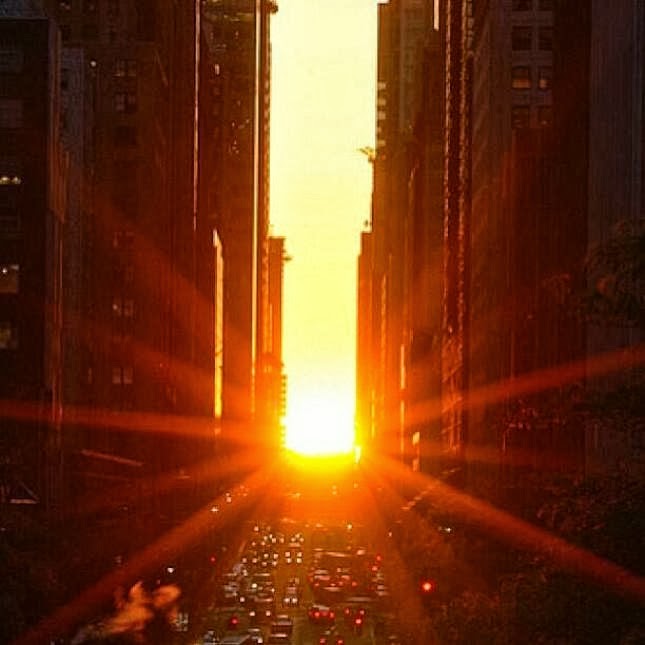
Manhattanhenge or Manhattan Henge
又称 曼哈屯悬日 或 曼哈屯落日
每年两次 发生在 5月和7月 或 12月和1月(每年的 夏至 和 冬至 前后均分的 大约20~21天)
的日升 或 日落时,
比如 2014年的夏至 是6月21日
那么
前数20~21天 是 5月30日; 后数20~21天 是7月21日
(一般是傍晚7~8点左右, 比如 8点28分~~)
夏至看日落, 冬至看日升 最佳景观, 日落时更壮观些
其缘由是 太阳横照 曼哈屯东西走向街道的景观
此刻 太阳直射 几乎垂直的 东西方向的街道(胡同儿~)
在两侧高耸的楼房之间狭小的街道上看到整个太阳
短短几(5~6)分钟 蔚为奇观

Satellite view of Manhattan centered on the intersection of Park Avenue and 34th Street,
showing directions and local times of sunsets (solid arrows) and sunrises (dotted arrows)
during Manhattanhenge (black), summer solstice (red),equinoxes (purple),
and winter solstice (blue) in 2011.
Times marked * have been adjusted for daylight saving.
去年 抽空去拍, 很难找到理想合适的地点, 拍的不理想
看来 想成点儿事儿 不易 啊, 嗯, 哈 ~:)










这是 从东河 East River 东岸 西拍 曼哈屯 42街 42nd St. (河边看到的是 联合国大厦)
is an astronomical event during which the setting sun is aligned with
the east–west streets of the main street grid for the borough of Manhattan, in New York City.
This occurs twice a year, on dates evenly spaced around the summer solstice. (sunset)
The first Manhattanhenge occurs around May 28, while the second occurs around July 12.
According to the Commissioners' Plan of 1811, the main traffic grid for Manhattan
is rotated 29° away from true east-west. Thus, when the azimuthfor sunset is 299°
(i.e., 29° North of West), sunset aligns with the streets on that grid.
A more impressive visual spectacle (and the one commonly advertised as Manhattanhenge)
occurs a couple of days after the first such date of the year, and a couple of days before
the second date, when a pedestrian looking down the centerline of the street towards
New Jersey can see the full solar disk slightly above the horizon and in between
the profiles of the buildings.[2]
The precise dates of Manhattanhenge depend on the date of the summer solstice,
which varies from year to year but remains close to June 21. In 2014, the "full sun"
Manhattanhenge occurred on May 30 at 8:18 p.m., and on July 11 at 8:24 p.m.[1]
The dates in which sunrise aligns with the streets on the Manhattan grid are
approximately December 5 and January 8 – spaced evenly around the winter solstice.
wiki
en.wikipedia.org/wiki/Manhattanhenge
上文讲了 夏至 和 曼哈吞悬日的关系, 冬至 向东看升日,夏至 向西看落日。


曼哈屯 日落 本来没人太注意或如此称谓
大约 2002年 有人 铸了 Manhattanhenge 这个词, 就火冒起来了
其实 它是 套自 大英帝国 的巨石阵日照 Stonehenge , 如上图所示
Astrophysicist Neil deGrasse Tyson coined the term Manhattanhenge in 1996 (some said 2002?),
inspired by its likeness to Stonehenge,
where the sun aligns with concentric circles of vertical stones on each of the solstices.
(本文图片 多是借用,版权归原作者, 谢谢。)
.
